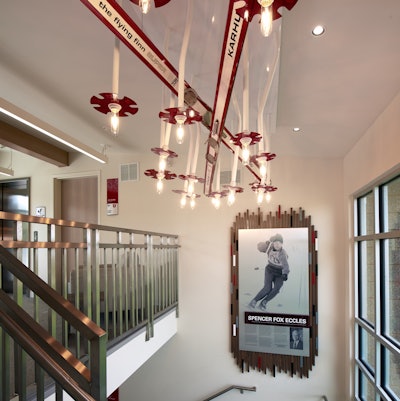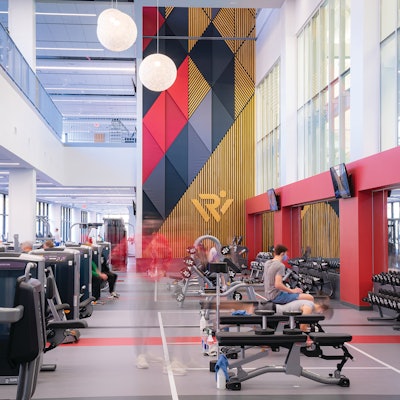
Sports venues are high maintenance. The term takes on literal meaning when the sheer volume of activity space in recreation centers and arenas is considered, along with the rafters, ductwork and light fixtures located in the loftiest reaches of such venues.
AB asked facility operators to identify the features or areas of their venues that are hardest to clean and otherwise take care of, and 20 out of 28 respondents identified hard-to-reach areas that are elevated well above floor level. Specifically, seven mentioned ductwork and vents, five pointed to rafters/trusses and another five to light fixtures, and two said they struggled with roofs, eves and overhangs. One respondent seemed to rue the day his facility decided to display available fitness equipment by hanging inventory samples as a sort of heavy-duty wall art. The wall happens to be 30 feet high.
We also asked our sample just how — and how often — they clean these building elements (turns out, not very often), as well as how, in their opinion, the facility might have been designed to ease the maintenance burdens lurking above. “Have the company who designs the facility clean the facility to see how hard it is to reach these areas to clean them,” offered one respondent rather bluntly.
So, we also consulted a leading sports and recreation architect to weigh in. Here’s what we learned.
Invest early in a lift
“The single most important decision about cleaning high spaces is determining what equipment will be required to reach the equivalent of two- to three-story high spaces,” says a principal at our chosen sports and recreation architecture firm. “We recommend scissor or boom lifts.”
Easy to operate and extremely safe, scissor lifts have a small footprint, a tight turning radius and are light enough to traverse most special sports flooring without much concern for damage. They can reach heights of up to 40 feet, yet are compact enough when not in use to be stored in a small space — ideally one designed with a charging station. In fact, a scissor lift can fit in a typical elevator. Says our architect, “We have actually mapped out the route a lift would use on a narrow pool deck to illustrate it can effectively navigate around diving boards and lifeguard stands.”
Tim Behland, director of personal training at the University Club of Chicago, tries to clean the ceiling fans and vents in his 20-foot-high strength training center with dusters at the end of extension poles, but those only go so far. “Several times per year we bring in a scissor lift to facilitate a deep cleaning,” Behland says, adding, “The scissor lift has damaged some areas of the floor, which have been repaired to accommodate the lift in the future.” (He mostly regrets not being able to lower the fans for floor-level cleaning.)
Two other survey respondents confessed to making do with far-reaching dusters as best they can, including the reader with the fitness equipment wall art, but six in addition to Behland specifically mentioned lifts as part of their arsenal for everything from duct cleaning to window washing.
Boom lifts are the preferred choice for larger venues, such as arenas, as they can reach greater heights. However, their greater size and weight will require larger storage space and sports surface protection measures.
In either case, investing in a lift is money well spent, according to the architect, who says, “While the cost of a lift is not insignificant, when compared to the cost of a new facility it has little impact on the overall budget.”
Location, location
 photo of Spence Eccles Ski Team Building, University of Utah by Scot Zimmermann
photo of Spence Eccles Ski Team Building, University of Utah by Scot Zimmermann
Jim Tomsic, facility director at the Medical University of South Carolina Wellness Center in Charleston also points to the natatorium as one of his problem areas — namely, the upper-floor windows and exposed fabric ductwork. “The worst part is that the windows separate the pool area from our indoor track,” he says. “As you walk or run around the track, you look through dirty glass into the pool area and see the accumulated fuzz on the ductwork and guidewires.”
Cleaning these areas is challenging, but not impossible. “The fabric ducts were an addition during a renovation in 2005 to improve airflow in the pool room,” Tomsic says. “They suspended them at a level that is just below the upper windows, blocking access to those windows. You have to turn the air handlers off, then use a lift to squeeze between the deflated ducts. The facility should have been designed with adequate ventilation to start with. The retrofitted ducts have made a huge improvement to air distribution, but at the expense of cleaning/maintaining anything above them. At least the fabric ducts will deflate. So glad they did not use metal ducts.”
Adds our chosen architect, “Often, as a cost-savings measure, we will use fabric ducts in high-bay spaces such as a gym or natatorium. Dust will accumulate on any duct in a high space and will require cleaning every few years. In the case of fabric ducts, they are advertised as being cleanable because they can be taken down and washed. This would require lift equipment to remove and reinstall the ducts. Unfortunately, what we have heard from our client institutions is that most have never taken down the ducts to clean them.”
Ideally, the amount of fuzz floating around a high-bay area can be limited by the efficiency of the HVAC system itself.
“In your home, the better the air filter in your furnace, the cleaner your house will be. This holds true for large recreation facilities, as well,” the architect says. “However, high-quality air filters for larger air-handling units are very expensive. Sitting in a maintenance review meeting, a facility engineer remarked that he loved the idea of using high-quality filters in his facility, but when budgets get tight — and they always do — he said the first thing that gets cut are the expensive filters.”
 photo of Nicholas Recreation Center courtesy of University of Wisconsin
photo of Nicholas Recreation Center courtesy of University of Wisconsin
Many of today’s sports and recreation venues incorporate the modern aesthetic of pendant-style lighting, some elaborate in design, which makes them all the harder to keep clean. But even standard light fixtures can pose maintenance issues depending on where they’re located.
“Hanging lights over pools and stair landings always presents both a cleaning and a re-lamping problem,” the architect says. “I still come across older pools with lights over the water. New pools will typically have perimeter lighting, which can be reached by a lift, but stair landings present a greater challenge. Wall-mounting fixtures at a landing allows them to be reached by a ladder for easy cleaning and re-lamping. Also, you can clean the tops of the fixtures, which you often see when coming down the stairs.
“In some larger sports venues, a light bar system is often used, which can be lowered to the floor for cleaning and re-lamping similar to a center-hung scoreboard. With the advancement of LED lighting, re-lamping fixtures is less frequent, but they can still get dirty.”
Understanding the facility’s needs
All stakeholders need to consider the cleaning and maintenance of a facility early in the design and initial investment process.
On many college and university campuses, the athletic and recreation facilities are responsible for their own maintenance and cleaning, while others rely entirely on campus support, and some have a hybrid of campus support and their own maintenance and cleaning staff.
“Unfortunately, what we hear most often is how inadequate the campus maintenance departments are because they are not used to the significant cleaning required in a facility that is open 18 hours a day and used by very active individuals,” says our chosen architecture expert. “As with all of our projects, we have specific meetings with facility, maintenance and custodial staff during design to understand all potential maintenance issues. Many universities and some municipalities have predetermined standards for mechanical equipment, cleaning supplies and techniques and finishes. In some cases, custodial staff are contracted, but we still meet with them to understand their needs.”





































